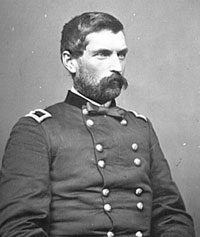
James Patton Anderson (1822-1872)
John Gibbon (April 20, 1827 - February 6, 1896) was a career U.S. Army officer who fought in the American Civil War and the Indian Wars.
Early Life
Gibbon was born in Philadelphia, Pennsylvania, but was raised in North Carolina. He graduated from the U.S. Military Academy in 1847 and was commissioned a second lieutenant in the 3rd U.S. Artillery. He served in the Mexican War and as an artillery instructor at West Point, where he wrote The Artillerist's Manual in 1859. The manual was a highly scientific treatise on gunnery and was used by both sides in the Civil War.
Civil War
When war broke out between the states, Gibbon was serving as a captain of the 4th U.S. Artillery and became chief of artillery to Major General Irvin McDowell. In 1862 he was appointed brigadier general of volunteers and commanded the brigade of westerners known as the "Black Hat Brigade" (due to their distinctive black Hardee caps that Gibbon selected for them). He led the brigade into action against the famous Confederate Stonewall Brigade at Brawner's Farm in the Second Battle of Bull Run. He was still in command of the brigade during their strong uphill charge at the Battle of South Mountain, where General Joseph Hooker exclaimed that the men "fought like iron". From then on the brigade was known as the "Iron Brigade". Gibbon led the brigade for the last time at the Battle of Antietam, where he was forced to take time away from brigade command to personally man an artillery piece in the bloody fighting at the Cornfield.
Gibbon was promoted to command the 2nd Division, I Corps at the Battle of Fredericksburg, where he was wounded. He recovered in time for the Battle of Chancellorsville, but his division was in reserve and saw little action. At the Battle of Gettysburg, he commanded the 2nd Division, II Corps and temporarily commanded the corps on July 1 and July 2, 1863, while Maj. Gen. Winfield S. Hancock was elevated to command larger units. At the end of the council of war on the night of July 2, army commander George G. Meade took Gibbon aside and predicted, "If Lee attacks tomorrow, it will be on your front." And his division did bear the brunt of fighting during the defense against Pickett's Charge on July 3, when Gibbon was again wounded. While recovering from his wounds, he commanded a draft depot in Cleveland, Ohio.
Gibbon was back in command of the 2nd Division at the battles of the Wilderness, Spotsylvania Court House, and Cold Harbor. During the Siege of Petersburg Gibbon became disheartened when his troops refused to fight at Ream's Station. He went on sick leave, but his service being too valuable, he returned to command the newly created XXIV Corps in the Army of the James. His troops helped achieve the decisive breakthrough at Petersburg, capturing Fort Gregg, part of the Confederate defenses. He led his troops during the Appomattox Campaign and blocked the Confederate escape route at the Battle of Appomattox Courthouse. He was one of three commissioners for the Confederate surrender.
Indian Wars
Gibbon stayed in the army after the war. He reverted to the Regular Army rank of colonel and was in command of the infantry at Fort Ellis, Montana Territory, during the campaign against the Sioux in 1876. Gibbon, General George Crook, and Lt. Col. George A. Custer were to make a coordinated campaign against the Sioux and Cheyenne, but Crook was driven back at the Battle of the Rosebud, and Gibbon was not close by when Custer attacked a very large village on the banks of the Little Bighorn River. The Battle of the Little Bighorn resulted in the deaths of Custer and some 261 of his men. Gibbon's approach on June 26 probably saved the lives of the several hundred men who were still under siege. Gibbon arrived the next day, and helped to bury the dead and evacuate the wounded.
Gibbon was still in command in Montana the following year when he intercepted a telegraph from Oliver O. Howard to cut off the Nez PercÚ, who were camped along the Big Hole River in western Montana. At the Battle of the Big Hole Gibbon's forces inflicted heavy losses, but became pinned down under Indian sniper fire. Gibbon held off the warriors until General Howard's forces arrived late on the second day of battle and drove them off. Gibbon was promoted to brigadier general in the regular army in 1885 and took command of the Army of the Pacific Northwest. He placed Seattle, Washington, under martial law during the anti-Chinese riots of 1886.
John Gibbon died in Baltimore, Maryland, and is buried in Arlington National Cemetery. In addition to his famous and influential Artillerist's Manual of 1859, he is the author of Personal Recollections of the Civil War (published posthumously in 1928) and Adventures on the Western Frontier (also posthumous, 1994).